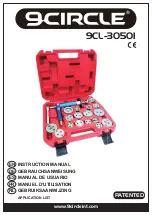
3
that can make a connection from one terminal
to another.
Shorting the battery terminals together
SERVICE
SPECIFIC SAFETY RULES FOR
THREADERS
•
•
Always use the support device provided with the
tool.
Loss of control during operation can result in
personal injury.
repair person using only identical replacement
parts.
This will ensure that the safety of the power
tool is maintained.
• Never service damaged battery packs.
Service
of battery packs should only be performed by the
manufacturer or authorized service providers.
• Under abusive conditions, liquid may be ejected
from the battery; avoid contact. If contact ac-
cidentally occurs, flush with water. If liquid
contacts eyes, additionally seek medical help.
Liquid ejected from the battery may cause irritation
or burns.
•
•
• Follow all charging instructions and do not charge
the battery pack or tool outside the temperature
Charging
range may damage the battery and increase the risk
•
Keep sleeves and jackets buttoned while operat-
ing the tool. Do not reach across the tool or pipe.
Clothing can be caught by the pipe or the tool resulting
in entanglement.
Only one person must control the work process
and tool operation.
Additional people involved in
the process may result in unintended operation and
personal injury.
•
•
•
as oil.
•
of support device used.
This will reduce the risk of
striking, crushing and other injuries.
Do not use dies that are showing signs of wear,
dull, or damaged.
Sharp cutting tools require less
torque and the tool is easier to control.
•
Do not store die heads in tool to prevent metal on
metal wear.
• Chemical Burn Hazard. Keep coin cell battery
away from children.
WARNING
Some dust
sawing, grinding,
creat
drilli
ed by power sanding,
ng, and other
construction activities contains chemicals known to
cause cancer, birth defects or other reproductive
harm. Some examples of these chemicals are:
SYMBOLOGY
Volts
• lead from lead-based paint
• crystalline silica from bricks and cement and other
masonry products, and
• arsenic and chromium from chemically-treated
lumber.
Your risk from these exposures varies, depending on
how often you do this type of work. To reduce your
exposure to these chemicals: work in a well ventilated
area, and work with approved safety equipment, such
as those dust masks that are specially designed to
Direct Current
Safety alert symbol
Read operator's manual
Do not wear gloves while pushing
on or near moving parts
Always use support arm
Keep hands away from moving parts
Do not use a battery pack or tool that is
damaged or modified.
Damaged or modified
batteries may exhibit unpredictable behaviour
resulting in fire, explosion or risk of injury.
Do not expose a battery pack or tool to fire or
excessive temperature.
Exposure to fire or
temperature above 130°C (265°F) may cause
explosion.
WARNING
Do
batteries.
not charge non-rechargeable
ADDITIONAL BATTERY SAFETY RULES
WARNING
To reduce the risk of fire, personal
injury, and product damage due to
a short circuit, never immerse your tool, battery
pack or charger in fluid or allow a fluid to flow inside
them. Corrosive or conductive fluids, such as
seawater, certain industrial chemicals, and bleach
or bleach-containing products, etc., can cause a
short circuit.
•Always use common sense and be cautious
when using tools.
It is not possible to anticipate
every situation that could result in a dangerous
outcome. Do not use this tool if you do not
understand these operating instructions or you feel
the work is beyond your capability; contact
MILWAUKEE
®
Tool or a trained professional for
additional information or training.
•
Maintain labels and nameplates. These carry
important information.
If unreadable or missing,
contact a
MILWAUKEE
®
service facility for a
replacement.
Regulatory Compliance Mark (RCM).
This product meets applicable
regulatory requirements.
Do not dispose of electric tools
together with household waste
material. Electric tools and electronic
equipment that have reached the end
of their life must be collected
separately and returned to an
environmentally compatible recycling
facility.
Only use
MILWAUKEE
®
11-R series or
equivalent die heads.
Other die heads may not fit
correctly in the tool increasing the risk of
equipment damage and personal injury.


























